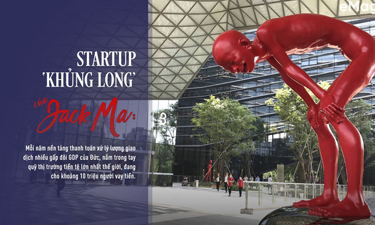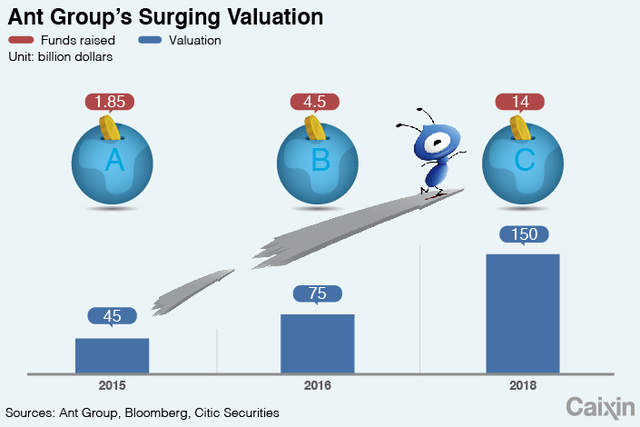Jack Ma’s ‘monster’ startup: valued at nearly US $ 200 billion, the number of customers accounts for 1/4 of the world’s population, earning US $ 2 billion / quarter
- Tram Ho
Investors had to wait a long time before Ant Group – the Chinese financial technology giant – a subsidiary of Alibaba Group announced its IPO plan last month – triggered one of the most significant deals. The most anticipated in the world.
Valued at nearly $ 200 billion, Ant – the parent company of payment application Alipay is currently the most valuable technology startup in the world. Their cross-listing plan on Hong Kong and Shanghai markets could become the world’s largest IPO deal this year. The listing will create an impetus for both of these stock markets at a time when the global outlook is bleak due to the effects of the Covid-19 epidemic.

Investors see Ant as a heavy weight stock with good investment prospects thanks to domestic payment systems, diverse financial services, advanced technology capabilities and their global expansion potential.
“Monster” named Ant Group
Originating from Alipay – an Alibaba payment platform founded in 2004, Ant has grown into a “giant” giant, owns the world’s largest payment service and operates the largest monetary fund. world. Ant’s combination of online financial services includes payment, banking, insurance, credit, asset management, lending, corporate credit and crowdfunding.
Ant also holds stakes in businesses from retail, entertainment, real estate, logistics, tourism and health care. All of these combinations will form a business complex that meets all aspects of customer needs with daily services.

However, the increasing influence of the company by the company has also caught the authorities’ attention. In less than two decades, Ant and emerging financial technology companies have brought profound changes to China’s financial industry, prompting legal changes.
Their extensive access to customer data and rapidly changing technologies have raised concerns from authorities about the risks associated with transparency, confidentiality and monopoly in the market. .
According to the company’s website, Ant divides its business into four areas: digital finance, insurance, international businesses and artificial intelligence technology. Through Alipay, Ant controls an enormous amount of digital traffic – providing their online financial services to individual customers as well as data and technology support for corporate customers.
By the end of March, Alipay was used by 1.3 billion people worldwide, including 900 million active users. Yu’E Bao – Ant’s money fund has more than 700 million investors. Their Huabei customer credit service has 400 million users. The total amount of money managed by Ant’s investment platform has exceeded 4 trillion yuan ($ 574 billion).
Upon achieving success in China, Ant is intending to go global. By investing in the digital wallet business such as India’s Paytm, Ant ensures access to more than 2 billion global customers – that’s a quarter of the world’s population.
The size of Ant’s financial business surpasses that of major banks in China, while the company’s technological influence is also expanding. Since 2017, Ant has been promoting its technologies such as blockchain, artificial intelligence, security, and IoT to promote its reputation as a provider of financial technology to merchants and financial institutions. In 2018, Ant launched a financial technology delivery platform. More than 40 paid products have been released since then.
In June, Ant changed its name to Ant Group to better suit its diverse business activities.
Of course, financial services are still Ant’s backbone and will still be a major source of revenue for them in the future. Payment, credit, asset management and insurance are the main sources of profits for Ant, although the company is trying to find other growth points from technology services and international business. .
From a tiny ant to a “giant”
There is no doubt that Alipay is Ant’s mainstream growth engine and contributes greatly to its massive valuation. Starting with 17 years ago to solve the payment difficulties on Alibaba’s Taobao platform, Alipay appears like China’s PayPal. Currently, the number of active users on Alipay is 3 times that of PayPal.
Alipay remains a pioneer in the field of financial technology in China, leading most of the new business operations from quick payments to online asset management and credit. That helps them attract a large number of users. September 2019 data shows that 80% of Alipay users use more than 3 of their financial services while 40% will use all services.

Ant’s value has grown bigger and bigger over the years.
However, Alipay cannot be invincible forever. Since 2014, the rise of Tencent’s WeChat Pay has created a significant threat to Alipay. In 2019, Alipay processed 630 million transactions a day, while the same number of WeChat Pay was 1.51 million. However, the average transaction amount on WeChat Pay is still much smaller than Alipay.
Since 2018, these two companies have established a monopoly in China’s payment market. Although Alipay still dominates, WeChat Pay has a larger market share in mobile payment services with offline retailers.
However, analysts say that Alipay can accelerate thanks to the huge investments of Alibaba and Ant in physical retailers over the years.
In March, Alipay revealed its goal of developing the world’s largest digital local service platform, plans to work with 50,000 service providers and help 40 million merchants upgrade their technology capabilities in 3. year.
Since 2015, Ant has doubled his services by acquiring shares in food delivery website Ele.me. Ele.me then merged with Koubei, a local service platform bought by Alibaba in 2006, to create a new service segment.
In 2017, Ant once again teamed up with Alibaba to buy bike sharing service HelloBike. In 2018, Alibaba launched a banana supermarket Hema.
When expanding its service options, Ant also strengthened its role as a technology provider, targeting institutional customers. Currently, financial institutions are very interested in the services that Alipay provides.
Money printer
Although Alipay plays an important role in Ant’s business, it is struggling to make a profit for its payments business. Caixin newspaper realized that Ant’s payment segment was still in loss, reflecting a strong spending on technology and customer support.
Ant has not yet released the financial situation, but Caixin calculated based on Alibaba’s financial statements showing that Ant’s pre-tax profit in the first three quarters of 2019 reached 11.6 billion yuan, after losses. 1.9 billion yuan in 2018 and net profit of 13.2 billion yuan in 2017. Especially, Ant’s profit in the last quarter of 2019 reached $ 2 billion, largely thanks to credit services. online.
Ant launched Huabei consumer loan service in 2014, providing credits to buyers on Alibaba’s e-commerce platforms. Jeibei – a loan provider was launched in 2015. At the end of 2018, Jiebei announced a net profit of 3.5 billion yuan and Huabei achieved a net profit of 370 million yuan.

These two services were caught up by authorities in 2018 as they expanded their campaigns to limit risks to the lending industry. Since then, Ant has reorganized its credit business and turned Jeibei and Huabei into a multimedia platform that helps users receive bank loans. At the end of June 2019, Ant cooperated with 400 banks to provide loans.
Eric Jing – Ant Chairman in March said that a total of 1.7 trillion yuan worth of loans were issued through Ant’s platforms in 2019, up 72% from the previous year.
In addition to online credit services, Ant’s financial services such as online asset management and insurance also outperform most competitors. According to Citic Securities, Ant’s revenue on platforms could reach 100 billion yuan annually. By 2020, Ant’s revenue from insurance may exceed 1 billion yuan from 240 million yuan last year.
With such power and dominance, Ant could not avoid scrutiny from authorities.
The free flow of money within Ant’s chain of business operations is growing and growing without any supervision by authorities and banks. “Authorities do not control both Alipay and WeChat Pay.”
“With more than 1 billion users, Ant and Tencent have evolved into super-giant financial services platforms that have an impact on the entire financial industry. not close yet. ”
In December, the former director of the China Securities Regulatory Office Xiao Gang proposed a draft of new regulations requiring the two companies, Ant and Wechat, to open data to allow smaller competitors to access it. encourage competition and transparency.
However, according to some experts, the tightening of management agencies’ risk management is not bad news for big companies like Ant. With greater capacity to invest in technology and management, a better controlled market can empower the big players.
Source : Genk
